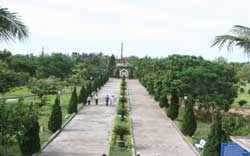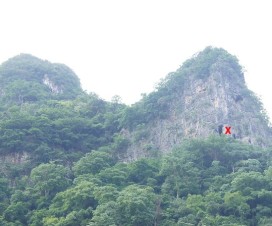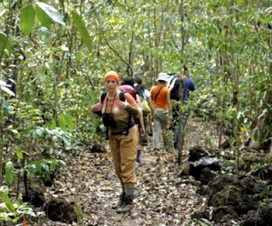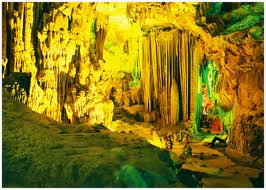 With its battlefields, monuments and museums, it is one place I will never be able to forget.
With its battlefields, monuments and museums, it is one place I will never be able to forget.
Vinh Linh District’s Hien Luong Bridge linking North and South Viet Nam is situated on the 17th parallel and was the temporary military border after the Geneva Peace Agreement on Indochina in 1954, following the French defeat in Dien Bien Phu battle.
The wooden footway supported by huge iron girders was built in 1928 for pedestrians. Improvements were added in 1931 and again in 1943 by the French to allow vehicles to cross the Ben Hai River. Seven years later, they further upgraded the bridge to serve their military purposes but it was badly damaged two years later during the war.
In later conflicts, it was bombed on numerous occasions, but it was rebuilt and restored, and stands as monument to the bloody struggles it witnessed.
The 178m long bridge that can be seen now is made from reinforced concrete with seven spans and steel girders.
Nguyen Van Tuy, an 80-year-old from Bac Ninh Province, asked his children to take him to Quang Tri to see with his own eyes the sites that have become well known across the world and to visit his younger brother who died there in 1972 and is now buried in the National Truong Son Martyrs’ Cemetery.
“I am here today, maybe my last journey, to view the victorious history of our people. The Hien Luong Bridge and its surroundings have become holy to us. It now stands for our thirst for peace and the reunification of Viet Nam,” Tuy said.
After the national victory in 1975, the military border was eliminated. In 1996, the Ministry of Transport decided to build a new bridge which is located just a few metres away from the old one to the west.
The old bridge that carried thousands of Vietnamese soldiers across to the South has become recognised as a national symbol and now attracts thousands of visitors per year.
From Hien Luong Bridge, you can take a 20km drive to the Old Citadel in Quang Tri Town.
The second must-see venue in the province was used as a military fort under the Nguyen dynasty. During the French and American occupation, it was used as a prison to hold Vietnamese patriots.
The citadel was built in 1802 in Trieu Phong District then moved to today’s location seven years later.
The first citadel was made of soil and rebuilt using bricks with towers at each corner that were used as sentry boxes.
With a perimeter of 2,080m, walls of 4m high, and a deep moat surrounding the complex, the citadel was an ideal base for the army.
During its 146 years (1809-1945) under feudalism, the citadel was the centre of politics, economics and military operations for the province and a tactical stronghold for Hue to the north.
The town was liberated on May 1, 1972 but the Sai Gon and American troops were hell-bent on recapturing the citadel, and it suffered the devastating effects of the ensuing battle.
During the 81-day siege, they dropped all kinds of ordnance including high explosive, napalm, 7-tonne and cluster bombs onto the town, concentrated on the citadel.
In total, an estimated 328,000 tonnes of explosives were dropped on the area, the equivalent of seven Hiroshima atomic bombs. During that time, the Vietnamese soldiers had to endure more than 100 bombs and 200 shells per day.
Today, there is almost nothing left of the old citadel.
The gate has been restored at the historic site and there is a small museum where visitors can learn more about those horrific days through objects and pictures that are on display. There is also a memorial temple dedicated to the heroes who made the ultimate sacrifice for national reunification.
In the future, restoration work will be carried out to comprehensively restore the citadel and return it to its former importance and stature.
Further north from Dong Ha, the provincial capital of Quang Tri, it takes just 20 minutes by car to the Vinh Moc Tunnels.
The tunnels were part of Vinh Linh District’s system of underground villages during the war.
To minimise casualties, people from the district were forced to live underground to avoid the bombing.
They dug trenches so they could travel in relative safety and tunnelled even further underground to develop living spaces.
There are 114 tunnels with a total length of 40km and more than 2,000km of trenches and ditches in the district. Vinh Moc is the most famous because of its position and function during that time.
The tunnels used to be thousands of metres long but now only 1,700m remain. This underground network has 13 exits, seven opening to the sea and six to the hills while it is divided into three layers, the deepest of which is 23m deep.
They are connectedly by a 768m main axis that is 1.6 to 1.8m high and 1.2 to 1.5m wide, along both sides of which are housing chambers where families ate, slept and co-existed.
There is also a large underground meeting hall with a seating capacity of 50 to 80 people, which was used for meetings, movies, artistic performances, surgery and even a maternity ward, where 17 babies were delivered.
“It is an incredible feat of labour. I find it hard to squeeze through these tunnels. I really admire the people who not only lived but also fought in such uncomfortable conditions for years,” said Tuy’s son Nguyen Tien Hoan.
“It’s hard to believe that 17 babies were born here, a symbol of the immortality of the people of this land,” said Hoan who emerged from the tunnels after spending just a few minutes underground.
The National Truong Son Martyrs’ Cemetery was the last venue that Tuy and his family visited to view his brother’s grave.
The cemetery is located on the top of a hill surrounded by eight smaller hills, like an eight-petal flower, in Vinh Truong Commune, 25km northwest of Dong Ha.
The 106ha cemetery is home to more than 10,200 fallen soldiers and is divided into five sections according to where each soldier was from, with a memorial monument situated at the top.
The Memorial of the Nation to Soldiers’ Sacrifices has three sides representing the three Indochinese countries, leaning on each for support during their fight against their common enemy. Between sections four and five is a group of monuments dedicated to the heroism of Battalion 559 and the Viet Nam-Laos solidarity. The cemetery is the resting-place of many soldiers who fell on the Ho Chi Minh Trail and on battlefields across the central part of the country.
It is the largest memorial site in the country, reflecting the people’s deep sorrow, gratitude and respect for those who sacrificed their lives for the liberation of the nation.
Every year, it welcomes more than 20,000 visitors from around the country.
Source: english.vietnamnet.vn




